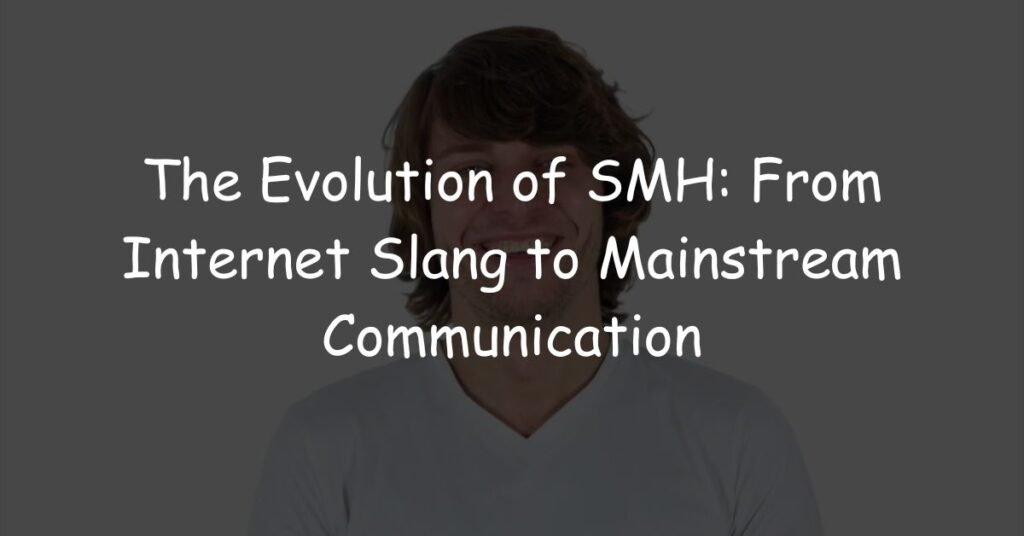Have you ever received a message with “SMH” and wondered what it means? You are not alone. This acronym appears everywhere in digital communication today. From social media posts to messaging apps, people use SMH constantly.
Many professionals struggle with internet slang in workplace settings. Understanding these terms helps you communicate better. It also prevents confusion in important conversations.
This guide explains the complete SMH meaning. You will learn professional alternatives that work in business settings.
What Does SMH Stand For? Complete Definition and Context

SMH stands for “Shaking My Head.” This reaction acronym represents the physical gesture people make when they feel surprised or frustrated.
People use SMH to show different emotions. These include disappointment, disbelief, frustration, and disapproval. Sometimes it shows mild amusement or skepticism too.
Think about when you shake your head in real life. You might do this when someone makes a silly mistake. Or when something unexpected happens. SMH captures this exact feeling in digital communication.
For example, someone might write: ” He forgot his keys again… SMH.” This shows gentle frustration without being mean.
See Also: Gyatt Meaning / What It Stands for in Text, Slang in 2025
SMH in Different Communication Contexts
Texting between friends uses SMH casually. People send it when sharing funny stories or minor complaints. It feels natural and informal in these settings.
Social media platforms see SMH in comments and posts. Users react to news, videos, or other people’s content with this acronym. It shows their quick reaction without typing long responses.
Professional communication should avoid SMH completely. Business emails, work messages, and client conversations need clear, respectful language. SMH sounds too casual and might confuse people.
See Also: Plancha Meanings: Living Contexts For 2025
The Evolution of SMH: From Internet Slang to Mainstream Communication

The acronym SMH started in the early 2000s. Texting culture created many short forms to save time and space. People needed quick ways to express emotions.
Social media platforms helped SMH spread fast. Twitter users loved short expressions that fit character limits. Tumblr and Facebook communities adopted it quickly too.
TikTok and Instagram made SMH even more popular. Young users shared videos and posts using this reaction acronym. It became part of everyday online slang.
Today, SMH appears across all age groups. Even older adults encounter it in family messages and social media comments. Understanding its meaning helps everyone communicate better.
Cultural Impact
Different generations use SMH differently. Younger people might use it more casually. Older adults often prefer complete sentences and clear language.
Digital communication styles vary across regions too. Some areas embrace internet slang more than others. Business cultures also differ in their acceptance of informal language.
Understanding these differences helps you choose appropriate communication styles. It prevents misunderstandings in professional and personal relationships.
Why SMH Can Be Problematic in Professional Settings
SMH can appear dismissive in workplace communication. Colleagues might think you are being rude or unprofessional. This acronym lacks the respect needed in business settings.
Tone misinterpretation happens often with internet slang. People cannot hear your voice or see your face. They might think you are angrier than you actually are.
Generational gaps create confusion too. Older colleagues might not understand SMH at all. International partners might find it confusing or inappropriate.
Communication Challenges
Clear communication requires complete thoughts and proper language. Acronyms like SMH can make messages unclear. Important business discussions need precision and clarity.
Emojis and abbreviations work well in casual settings. However, professional environments need formal language. This shows respect for colleagues and clients.
Professional communication builds trust and credibility. Using appropriate language demonstrates your competence and reliability. It helps you succeed in business relationships.
Professional Communication Standards
Business email guidelines discourage informal acronyms. Companies expect employees to use complete sentences and proper grammar. This maintains professional standards across all communications.
Client interactions require extra care with language choices. Customers and partners expect respectful, clear communication. Confusing internet slang can damage business relationships.
Different industries have varying communication expectations. Legal, medical, and financial sectors require very formal language. Creative industries might allow more casual communication styles.
Professional Alternatives to SMH for Polite Communication in 2025
Formal Business Alternatives
“That’s Quite Disappointing” works perfectly in professional communication. This phrase shows your feelings without sounding harsh. It maintains respect while expressing concern.
Use this alternative in performance reviews and project updates. It works well when discussing missed deadlines or quality issues. Clients appreciate this respectful approach to addressing problems.
Example: “The report submission was delayed again. That’s quite disappointing, as it affects our timeline.”
“This Presents Unexpected Challenges” focuses on solutions rather than blame. This constructive language helps teams work together better. It shows you are thinking about moving forward.
Team meetings benefit from this approach. Strategic planning discussions need neutral language like this. It keeps conversations productive and positive.
Example: “The budget changes present unexpected challenges we need to address together.”
“I Find This Concerning” expresses serious worry in a diplomatic way. Use this for important issues that need immediate attention. It shows the severity without being accusatory.
Policy discussions and compliance issues need this level of seriousness. Quality concerns also require this careful approach to communication.
Example: “The repeated safety violations are concerning and require immediate action.”
Semi-Formal Alternatives
“That’s Unfortunate Timing” shows empathy while acknowledging problems. This phrase works when external factors cause issues. It removes blame while expressing disappointment.
Project delays and scheduling conflicts benefit from this language. Cross-departmental communication stays positive with this approach.
Example: “The system maintenance during our presentation is unfortunate timing.”
“This Doesn’t Align with Expectations” provides direct but respectful feedback. Performance reviews and deliverable assessments need this clarity. It helps people understand what needs improvement.
Management communication requires this balance of honesty and respect. It guides improvement without damaging relationships.
Example: “The final design doesn’t align with the expectations we discussed last week.”
“I’m Surprised by This Development” expresses disbelief without judgment. Unexpected changes and surprising decisions need careful responses. This phrase shows curiosity rather than criticism.
Stakeholder communication benefits from this neutral approach. It opens dialogue instead of creating conflict.
Example: “I’m surprised by this development in the project timeline. Could we discuss the reasoning?”
Casual Professional Alternatives
“That’s Puzzling” shows thoughtful confusion without criticism. Team discussions and brainstorming sessions work well with this language. It invites explanation and discussion.
Colleague interactions stay friendly with this approach. It maintains relationships while expressing confusion.
Example: “The client’s request for fewer features is puzzling. Let’s explore their reasoning.”
“Interesting Choice” diplomatically questions decisions without being rude. Creative reviews and strategic discussions benefit from this neutral language. It opens conversation about different approaches.
Collaborative work needs this kind of respectful questioning. It helps teams explore options together.
Example: “That’s an interesting choice for the color scheme. What influenced this decision?”
“Well, That’s Something” acknowledges unusual situations with mild surprise. Casual team updates and informal observations work with this phrase. It shows awareness without strong judgment.
Water cooler conversations and light commentary use this approach. It keeps things friendly while noting unusual events.
Example: “They scheduled the meeting for 6 AM. Well, that’s something we don’t see often.”
Constructive Alternatives
“Let’s Explore This Further” turns confusion into opportunity. Problem-solving meetings and analysis discussions benefit from this approach. It shows leadership and solution-focused thinking.
Team leadership requires this kind of constructive language. It moves conversations toward positive outcomes.
Example: “The results are different than expected. Let’s explore this further to understand why.”
“This Requires Additional Consideration” shows thoughtful analysis without rush to judgment. Decision-making processes need careful evaluation. This phrase buys time for proper analysis.
Executive communication often requires this measured approach. Strategic planning benefits from this careful language.
Example: “The proposal has merit, but this requires additional consideration before we proceed.”
“I’d Like to Understand This Better” shows curiosity and openness to learning. Clarification requests and investigative discussions work well with this phrase. It demonstrates professional growth mindset.
Professional development conversations benefit from this approach. It shows willingness to learn and improve.
Example: “The new process seems complex. I’d like to understand this better before implementation.”
How to Choose the Right SMH Alternative for Different Situations
Context assessment helps you pick the right alternative. Consider your relationship with the person receiving your message. Formal relationships need more respectful language.
Communication medium affects your choice too. Emails need more formal language than quick Slack messages. Face-to-face conversations allow for more casual alternatives.
Situation severity determines how strong your response should be. Minor issues need gentle alternatives. Serious problems require more direct language.
American Workplace Considerations
Corporate culture varies significantly across companies. Some organizations embrace casual communication styles. Others maintain strict professional communication standards throughout all interactions.
Industry standards create different expectations too. Tech companies might accept more informal language. Law firms and medical practices require very formal communication at all times.
Regional business practices across America show variations too. East Coast business culture tends toward more formal communication. West Coast companies often embrace casual approaches.
More Post: Katz Meanings and How to Use It in Text in 2025
Best Practices for Professional Communication in 2025
Digital Communication Guidelines
Professional email requires complete sentences and proper grammar. Avoid all internet slang and acronyms in business correspondence. Use clear subject lines and organized content structure.
Clear communication prevents misunderstandings and saves time. State your purpose early in messages. Use specific details and actionable language throughout.
Messaging apps in workplace settings need boundaries too. Slack, Teams, and similar platforms require professional language. Save casual communication for appropriate channels only.
Social media presence affects your professional image. Keep personal accounts separate from work-related content. Maintain professional standards even in personal posts that colleagues might see.
Building Communication Skills
Emotional intelligence helps you choose appropriate language for different situations. Consider how your words might affect the reader. Choose alternatives that build rather than damage relationships.
Cultural sensitivity matters more than ever in diverse workplaces. Some colleagues might not understand internet slang or cultural references. Use inclusive language that everyone can understand.
Tone awareness prevents communication problems before they start. Read your messages aloud before sending them. This helps you catch potentially problematic language or unclear statements.
Practice active listening in all conversations. This helps you understand context better. You can then choose more appropriate responses that match the situation.
Common Mistakes to Avoid When Replacing SMH
Overcorrection Issues
Excessive formality can make casual interactions uncomfortable. Not every situation requires the most formal alternative. Match your language to the relationship and context appropriately.
Tone mismatch happens when your alternative doesn’t fit the situation. Mild disappointment needs gentle language. Serious concerns require stronger alternatives that show appropriate gravity.
Context confusion occurs when you use formal alternatives in casual settings. Friends and family might find overly professional language strange or distant.
Balance is key in all communication choices. Consider your audience and relationship carefully. Choose alternatives that feel natural while maintaining appropriate professional standards.
Implementation Challenges
Consistency matters across all your communications. Develop habits that work in multiple settings. This prevents accidentally using inappropriate language in important messages.
Authenticity keeps your communication style genuine. Choose alternatives that feel natural to your personality. Forced language sounds fake and damages credibility.
Timing considerations affect which alternatives work best. Urgent situations might need direct language. Less critical issues allow for more diplomatic approaches.
Practice using these alternatives in low-stakes situations first. This builds confidence for important communications. It also helps you find which alternatives feel most natural.
See Also: 2025+Pookie Meaning / Interpretations and Alternatives
Conclusion
SMH meaning is now clear to you. This acronym stands for “shaking my head” and expresses various emotions from disappointment to disbelief. Understanding internet slang helps you navigate modern digital communication better.
Professional communication requires thoughtful language choices. The alternatives provided give you options for every workplace situation. From formal business settings to casual team interactions, you now have appropriate responses.
Clear communication builds stronger relationships and prevents misunderstandings. Choose alternatives that match your context and audience. Practice using these phrases to build confidence in professional settings.








